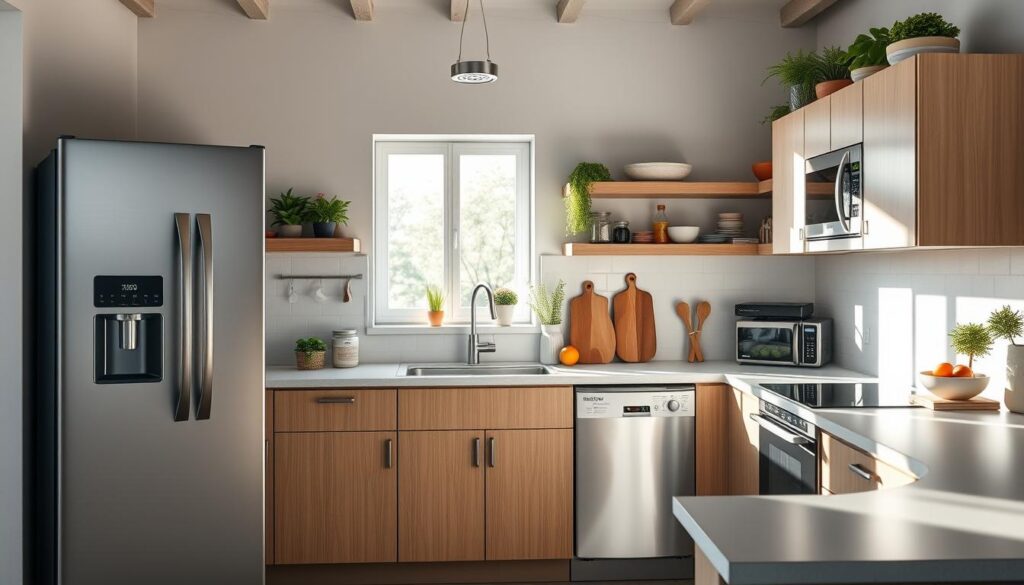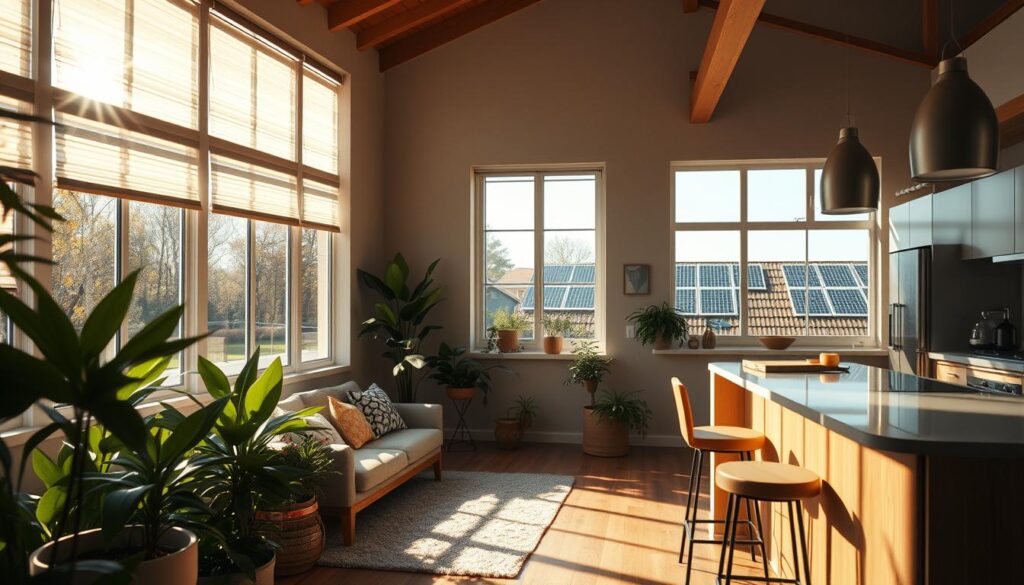As a homeowner, you’ve probably seen your utility bill jump up. The average electric bill in the U.S. is $137 a month. It’s key to find ways to cut costs and save more. Simple changes like adjusting your thermostat and using energy-efficient appliances can make a big difference.
Lowering your utility bills can save you money and help the planet. Using appliances that use less energy can cut down your bills. These tips can greatly reduce your energy use and expenses.
Table of Contents
Key Takeaways
- Adjusting thermostat settings can lower annual heating and cooling costs by around 10% and improve energy efficiency.
- Using energy-efficient appliances, such as those with the Energy Star label, can reduce energy consumption and lower utility bills.
- Implementing smart usage habits, such as running full loads in dishwashers and washing machines, can result in substantial energy and cost savings over time.
- Unplugging electronic devices when not in use and utilizing power strips can help reduce energy consumption and lower utility bills.
- Optimizing energy usage through utility bill hacks can lead to significant reductions in monthly utility bills and promote energy efficiency.
- Reducing utility bills can have a positive impact on the environment by mitigating climate change and reducing greenhouse gas emissions.
- Energy-efficient practices can increase the resale or rental value of apartments and encourage a sense of communal responsibility within the community.
Understanding Your Utility Bills: A Complete Breakdown
To cut down on your utility bills, it’s key to know what your bill includes. The average cost of electricity in the U.S. is 14.12 cents per kWh, as the Energy Information Administration (EIA) reports. Your electric bill has two main parts: the cost of electricity itself and the cost to deliver it to you.
When you look at your utility statement, find the energy usage section. It shows how much energy you used in kilowatt-hours (kWh). This info can help you spot ways to save money. You might also see tiered billing, where prices change based on how much you use. Some places have special rates for peak times or demand charges.
Common Utility Bill Components
A typical utility bill has several parts. You’ll see charges for electricity, its delivery, and sometimes extra fees. These can include costs for upkeep, salaries, taxes, and renewable energy. Knowing these can help you figure out why your bills might be high.
How to Read Your Utility Statements
To make the most of your utility statement, look for details on monthly and daily usage. You’ll also find year-to-year comparisons. To find the cost per unit, divide your total bill by the kWh used in a month. This helps you understand your energy costs better.
Smart Ways to Reduce Your Monthly Utility Bills
There are simple ways to cut down on utility bills. One effective method is to adjust your thermostat settings. This can save up to 10% on heating and cooling costs. Also, using energy-efficient appliances and smart home technology can greatly reduce energy use and costs.
Here are some tips to lower your utility bills:
- Choose energy-efficient appliances and lights.
- Use smart home tech to track and manage energy use.
- Adjust your thermostat to save on heating and cooling.
- Seal air leaks and add insulation to cut down on heat loss.
By following these steps, homeowners can greatly reduce utility bills. This makes their homes more energy-efficient and smart. With the average American spending $380 on utilities monthly, these changes can make a big difference.
Homeowners can also get tax credits and incentives for energy-efficient upgrades. For example, installing solar panels or energy-efficient windows. These upgrades not only reduce utility bills but also boost your home’s value.
| Energy-Efficient Upgrade | Cost Savings |
|---|---|
| LED Bulbs | $225 per year |
| Energy-Efficient Refrigerators | 9% less energy consumption |
| Smart Thermostats | 10% less heating and cooling costs |
Energy-Efficient Lighting Solutions
Lighting uses about 15% of a home’s electricity, making it a big part of energy use. Switching to energy-efficient lighting can cut down on bills and help the environment. LED bulbs are a great choice because they use up to 90% less energy and last much longer than old bulbs.
Energy-efficient lighting has many benefits. For example, using LED bulbs can save a family about $225 a year. LEDs work well in many places, like replacing old bulbs, track lights, and outdoor lights. Some even turn off automatically when it gets light outside or when no one is around.
Benefits of LED Bulbs
- Use up to 75% less energy than incandescent lighting
- Last 25 times longer than incandescent bulbs
- Can save households hundreds of dollars annually
- Offer better performance and longer life spans than traditional bulbs
Energy-efficient lighting is a simple way to use less energy and save money. LED bulbs are now cheaper than ever, making it a great time to switch. By choosing these bulbs, homes can save money and help the planet.
| Type of Bulb | Energy Consumption | Lifespan |
|---|---|---|
| Incandescent | High | 1,200 hours |
| LED | Low | 25,000 hours |
Water Conservation Strategies That Work
Water conservation is key to lowering utility bills and saving energy. Simple tips can greatly cut down water use. For example, using water-efficient fixtures can save thousands of gallons yearly. Even a small leak can waste hundreds of gallons, showing the need for regular checks.
Effective strategies include:
- Optimizing irrigation systems to reduce water waste
- Installing rain barrels or rainwater harvesting systems for outdoor activities
- Using energy-efficient washing machines that use less water per cycle
- Limiting shower time to save gallons of water with each use
Also, fixing plumbing leaks can cut water bills by 10%, the U.S. Department of Energy says. Reducing outdoor water use by 5% can save an average family 300 gallons a month in summer. Energy Star appliances use 20% less water than standard ones, making them a smart choice.
By adopting these strategies, homes can lower bills and help the planet. The average home uses 320 gallons of water daily. Every small change helps a lot. Together, we can make a big difference in water and energy use, ensuring a greener future for all.
| Water Conservation Strategy | Water Savings |
|---|---|
| Upgrading to water-efficient fixtures | Thousands of gallons per year |
| Fixing plumbing leaks | 10% on water bills |
| Using energy-efficient washing machines | At least 20% less water per cycle |
Heating and Cooling Cost Reduction Methods
Heating and cooling costs can take up a big part of your bills. The Department of Energy says that good insulation can cut these costs by up to 30%. To save money, focus on making your home more energy-efficient and well-insulated. Using energy-saving solutions in your home is a good start.
To lower your bills, try proper insulation techniques. They help keep the air inside your home at a comfortable temperature. Also, smart thermostat benefits can help you use less energy. Adjusting your thermostat can save you money without making your home uncomfortable.
Proper Insulation Techniques
- Adding insulation to attics and around HVAC ducts can improve the home’s ability to retain climatized air
- Upgrading to energy-efficient windows can help improve insulation and reduce energy waste
- Properly sealing air gaps in a home can prevent significant energy losses
Smart Thermostat Benefits
Smart thermostats let you keep an eye on and control your energy use. They make it easy to use less energy. By tweaking your thermostat a bit, you can save money without feeling less comfortable.
| Method | Energy Savings |
|---|---|
| Proper Insulation | Up to 30% |
| Smart Thermostat | Up to 20% |
Kitchen Appliance Energy Optimization
Reducing your monthly utility bills starts with optimizing your kitchen appliances’ energy use. Energy efficiency is crucial, as these appliances use a lot of energy. The Energy Department suggests using energy-efficient appliances to cut down on energy use.
Keeping your appliances in good shape is also important. Regular cleaning and checking for damage helps them work better. This way, you can use less energy and save on bills.
Here are some tips to help you use less energy with your kitchen appliances:
- Choose energy-efficient appliances, like those with the ENERGY STAR label
- Keep your appliances well-maintained to ensure they work efficiently
- Turn off appliances when not in use to avoid standby power use
By following these tips, you can cut down on energy use and lower your bills. Remember, every little bit helps, and starting with your kitchen appliances is a great step.
| Appliance | Energy Consumption | Energy-Efficient Alternative |
|---|---|---|
| Refrigerator | 100-200 kWh/month | ENERGY STAR certified refrigerator |
| Dishwasher | 30-50 kWh/month | ENERGY STAR certified dishwasher |
Laundry Room Efficiency Improvements
Improving your laundry room can cut down on energy use and costs. One easy way is to wash clothes in cold water. This can save over half the energy needed for hot water washes. Also, always fill the washing machine to use energy more efficiently.
Keeping your dryer in good shape is key. Clean the lint trap after each use and do a deep clean once a year. Using dryer balls can also help clothes dry faster and reduce static. For even more savings, try air-drying your clothes instead of using the dryer.
Here are some more tips for a more efficient laundry room:
- Choose a newer washing machine that uses less water.
- Shorten the dryer hose to boost efficiency.
- Spin clothes extra in the washer to dry faster by 50%.
By following these simple steps, you can cut down on energy use and lower your bills. With electricity costs rising by up to five percent in 2022, it’s vital to manage your energy use. Making smart choices can help reduce waste and save money.
| Tip | Energy Savings |
|---|---|
| Cold water washes | More than half |
| Full load in washing machine | Maximizes energy usage efficiency |
| Good dryer maintenance | Crucial for efficient operation |
Smart Home Technology for Utility Management
Smart home technology has changed how we manage our utilities. It makes it easier to watch and control energy use. Homeowners can now save money by using smart devices to cut down on energy waste.
Smart devices give real-time feedback on energy use. This helps homeowners find ways to use less energy. For example, smart thermostats can lower heating and cooling costs. Smart outlets can also control energy use for electronics.
Best Smart Devices for Utility Monitoring
Top smart devices for monitoring utilities include smart thermostats, outlets, and lighting systems. These can be controlled from anywhere, helping homeowners save energy. Many devices also track energy use, giving detailed info.
Home Automation Setup Guide
Setting up home automation is simpler than it seems. First, pick the devices you want to automate, like thermostats and lights. Then, choose a hub to connect all devices for remote control. Finally, download the app and start automating your home. Smart technology helps manage utilities, saving energy and money.
| Device | Energy Savings |
|---|---|
| Smart Thermostat | Up to $219 annually |
| Smart Outlets | Up to 30% reduction in energy consumption |
| Smart Lighting Systems | Up to 40% reduction in energy consumption |
Investing in smart home tech and automation is a smart move. It helps cut down energy use and lowers utility bills. With the right devices and setup, you get convenience, efficiency, and security.
Seasonal Tips for Maximum Utility Savings
As the seasons change, so do the chances to cut down on utility bills. Homeowners can save money and make their homes more energy-efficient by using seasonal tips. For instance, in summer, running ceiling fans can cool rooms without using more energy.
Here are some seasonal tips for saving on utilities:
- Adjusting the thermostat to save on cooling costs
- Keeping cooling equipment in good shape to save energy
- Choosing lighting options that use less energy
By following these seasonal tips, you can save a lot on utilities. This helps make your home more energy-efficient. For more tips, check out the U.S. Department of Energy website.
| Season | Tip | Savings |
|---|---|---|
| Summer | Use ceiling fans | 10% on cooling bills |
| Winter | Lower thermostat by 10-15 degrees | 10% on heating bills |
Long-Term Investment Solutions for Utility Reduction
Investing in long-term solutions can cut down utility bills and help the planet. Solar panels are a great choice for this. They can save money on energy costs over time, as the Energy Department says.
Some benefits of solar panels include:
- Reduced utility bills
- Low maintenance costs
- Increased property value
Energy-efficient appliances and home weatherization also help. These investments can save money and lessen environmental harm.
By choosing solar panels and other energy-saving options, homes can save a lot. The average household spends about $329 monthly on various services. It’s key to look into long-term solutions for cutting utility costs.
| Utility | Average Monthly Cost |
|---|---|
| Electricity | $225 |
| Gas | $61.69 |
| Water and Sewer | $103.31 |
Creating Sustainable Habits for Ongoing Savings
Creating sustainable habits is key to using less energy and saving money. The Energy Department says these habits lead to ongoing savings. By using less energy, people can cut down on their bills a lot. For example, taking public transport or carpooling cuts down on fuel use and emissions.
Simple steps can help make sustainable habits a part of your life. Like turning off lights and appliances when not using them. Also, using power strips to turn off electronics at once saves energy.
Investing in smart thermostats can also save money on heating and cooling. Plus, recycling, composting, and choosing eco-friendly products help the planet. These small actions lead to big savings and a greener lifestyle.
Here are some tips for sustainable habits:
- Use energy-efficient appliances to cut down on energy use.
- Turn off lights and appliances when not in use to save energy.
- Take public transport or carpool to use less fuel.
- Invest in smart thermostats to save on heating and cooling costs.
By following these sustainable habits, you can save money and help the environment. Every little change helps a lot in reducing energy use and costs.
Common Mistakes That Increase Utility Costs
Many homeowners don’t know about the mistakes that raise their utility bills. These errors often hide in plain sight. The Energy Department says these hidden drains can really add up, making it key to spot and fix them.
Leaving lights and gadgets on when not needed is a big mistake. It can make your utility bills go up. Using old appliances also wastes more energy and costs more. Keeping your HVAC in good shape and changing air filters can cut down on energy use and bills.
To dodge these errors, pay attention to how you use energy. Use smart power strips to control vampire appliances. Get newer, energy-saving appliances and adjust your thermostat. These actions can lower your bills and reduce energy waste.
Hidden Energy Drains
- Leaving lights and electronics on when not in use
- Using outdated appliances
- Not maintaining HVAC systems regularly
Behavioral Patterns to Avoid
Knowing these mistakes and how to avoid them can save you money. Start by turning off unused lights and gadgets. Use power strips to manage energy. Also, make sure to keep your HVAC in top condition. These habits can make your home more energy-efficient and lower your bills.
Conclusion: Implementing Your Utility Savings Plan
Lowering your monthly utility bills is a long-term journey. It’s about becoming more energy efficient and saving money. By creating a detailed utility savings plan, you can manage your energy use well.
Begin with easy changes like using energy-saving light bulbs. Also, make your HVAC system work better and save water. These small steps can save you a lot of money each year.
Next, think about bigger changes like solar panels or smart home tech. These upgrades can cut your bills even more and help the planet too.
Being mindful and proactive is key to saving on utilities. Keep an eye on your progress and look for new ways to use less energy. With a good plan, you’ll enjoy a greener home and a better financial future.
FAQ
What are the common components of a utility bill?
A utility bill usually has parts like electricity, natural gas, and water. It also includes other services. Knowing what’s in your bill can show you where to save money.
How can I read and interpret my utility statements?
Utility statements give you details on your energy use and costs. Learning to understand them can help you find ways to cut down on your bills.
What are some smart ways to reduce monthly utility bills?
Smart ways to lower bills include adjusting your thermostat and using energy-efficient appliances. Smart home tech can also make a big difference.
How can energy-efficient lighting solutions help lower utility bills?
Switching to LED bulbs and smart lighting can cut down on energy use. It also lowers your costs for lighting.
What water conservation strategies can I implement to reduce utility bills?
Using efficient showerheads and low-flow faucets can save water. Greywater systems are another way to conserve and lower bills.
How can proper heating and cooling practices impact utility costs?
Improving insulation and using smart thermostats can save on heating and cooling. Regular HVAC maintenance also helps.
What are some tips for optimizing kitchen appliance energy usage?
Using energy-efficient appliances and maintaining kitchen gear can save energy. Smart cooking techniques also help lower costs.
How can laundry room efficiency improvements lower utility bills?
Energy-efficient washing and exploring drying options can save energy. Optimizing your laundry room usage also helps.
What smart home technologies can help manage utility costs?
Smart devices for monitoring and a home automation setup offer insights. They help you use energy more efficiently and save on bills.
How can seasonal tips help maximize utility savings?
Adjusting energy use with the seasons can save a lot. It’s especially effective in winter, summer, spring, and fall.
What long-term investment solutions can provide utility cost reductions?
Investing in solar panels and energy-efficient appliances can save money over time. Home weatherization projects also offer long-term savings.
How can developing sustainable habits lead to ongoing utility savings?
Adopting energy-efficient habits and reducing consumption can save money long-term. It’s about using energy wisely over time.
What common mistakes can increase utility costs, and how can they be avoided?
Ignoring energy drains and wasteful habits can raise costs. Knowing these mistakes and fixing them can help you save on bills.









